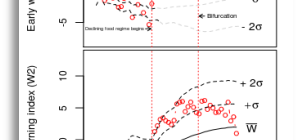
John Drake. Modeling Infectious Disease Agents Study (MIDAS) Network Meeting. April 28-30, 2015, Atlanta.

The elimination of malaria and other mosquito-borne pathogens is a major public health issue worldwide. A considerable obstacle to disease elimination in resource poor countries…

Emerging pathogens are among the most visible and costly threats to individual and public health. Antibiotics, vaccines, and the molecular revolution in biology have not…

This year is the 20th anniversary of the Programme on Epidemic Models held at the Isaac Newton Institute for Mathematical Sciences in Cambridge, UK. In…

Background A partial differential equation model of population growth and dispersal developed by Lewis and Karieva (1993) predicts that invading populations subject to an…

Above – A composite early warning index comprising all four indicators is highly sensitive to the onset of critical slowing down. a, Time-specific calculations of…

Background A partial differential equation model of population growth and dispersal developed by Lewis and Karieva (1993) predicts that invading populations subject to an Allee…





